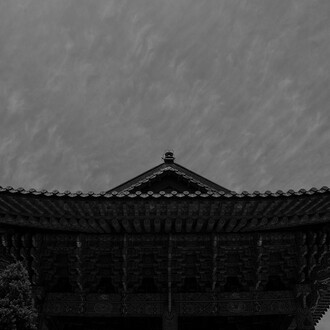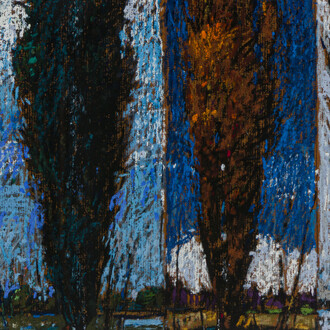Walking lines brings together the work of Diego Miccige, Tamika Rivera, Beatriz Morales, and Josefina Concha E., four Latinx and Latin American artists who engage the textile practice as a dynamic and embodied gesture. In their hands, ropes and strings become a path—walked, repeated, interrupted, and reimagined through material, process, and experience. Whether pierced into paper, knotted into fiber, dyed onto textile, or sewn into sculptural folds, these lines thread narratives that are at once personal and collective, tactile and symbolic. Rooted in diverse cultural histories and techniques, their work explores how traditions are carried, transformed, and made present through the act of making. In this context, the line is not only a visual element, but a material record of movement, labor and memory.
Diego Miccige’s pieces take shape from a structured, programmatic foundation—grids meticulously pierced into paper—that gradually opens into a sensitive, perceptual field shaped by light, line, and color. Drawing on the extensive history of textile traditions—particularly those rooted in pre-Columbian Andean cosmologies—Miccige imagines the grid as both a conceptual framework and a generative device. His works explore textile not only as a material practice but as a symbolic architecture of connection, continuity, and balance. In the series Minimal variations and Sacred of Huiracocha presented in the exhibition, subtle chromatic variations and geometric forms develop across the surface, where light is delicately caught in micro-reflections that resonate like a quantum of energy. At times resembling computer motherboards or schematic diagrams, the compositions organize geometry and space into dynamic systems of progression and tension, where even the blank areas feel magnetically charged. However, despite their precision, Miccige’s works oppose cold rationality. The artist’s approach is grounded in present perception, spirituality, and transformation. The modular, embroidered, and topographic constructions echo both ancient cosmologies and systems of mapping—from the Nazca lines to textile practices—while also engaging with contemporary networks and architectures of being that are at once systemic and deeply embodied.
Building upon this interplay between ancestral knowledge and contemporary experience, Tamika Rivera’s series Warikè, Hekiti Warikè cuyo emerges as an exploration of care, interconnectedness, and the spiritual and social bonds uniting us as living beings within a collective body. Reflecting on identity—beginning with her own Taíno ancestry and diasporic Caribbean history—Rivera problematizes contemporary weaponization of identity, deployed as a source of division. Instead, her work enhances identity as a space of difference that sustains the potential for unity. Through knotted, interwoven, and stitched structures, she constructs morphologies that evoke both human and social bodies: assemblages created not through separation, but through mutual support. Each of the three works presented in the exhibition suggest the presence of individual parts, distinct yet functionally connected, like organs within a living system. They gesture toward a heart, a skin, and an amulet—symbols of pulse, structure, and protection. Together, they act as vital beltways of life: from the beat to the shield, held by the amulet that carries a spiritual promise of care. Rivera’s work resists constriction and fixed borders, proposing instead a model of identity rooted in growth, expansion, and connection—reaching toward all the places we come from, and all the parts that make us whole.
Interrelation, tradition, and materiality are also present in Beatriz Morales’s research. In the series Tecuani—a Nahua word meaning ‘beast,’ ‘man-eater,’ ‘jaguar,’ or ‘undomesticated animal’—she works with agave fiber, a material sacred in pre-Hispanic Mexico and central to Indigenous cosmologies. Drawing from the vegetal world, Morales incorporates raw fiber into her work to create textures that resemble animal fur or human hair. Engaging the fiber’s organic unpredictability, she foregrounds its ancestral character and resistance to full control. Color is introduced through natural dyes—such as orange extracted from palo de Brasil and deep hues obtained from blends of pomegranate and campeche—further rooting the work in processes shaped by harvests, water, and the rhythms of nature. In her work embroidery and gesture coexist: delicate white stitches form linear marks and scattered points, while expansive areas of textile—stitched, layered, and textured—generate a painterly surface. At times, the composition brings to mind cosmic landscapes, with galaxies in motion, unfolding through shadow and light. The work is animated by contrasts—between chaos and order, artisanal and industrial, raw and refined—unfolding across multiple scales, where minute, controlled details emerge within vast fields of fiber and color.
Situated between organic unpredictability and structured repetition, Josefina Concha E.’s series Sempiterno [Everlasting] unfolds from the interplay of rational systematization and unforeseen outcomes. Concha works with a cotton canvas, sewing thick zigzags, wide stitches laid one line beside the next, forcing the surface into creases and folds through accumulation. The resulting pieces, hypnotic and heavy textiles with circular shapes, are not displayed flat against the wall but emerge as irregular, sculptural forms that push beyond the gallery’s corners and edges, entering the viewer’s space. The concentric lines of these works reminds both the rings exposed in a cut tree trunk and the layered formations of crystallized rocks, filling the room with a quiet sense of nature’s inner life and layered intimacy. Echoing geological and topographical patterns, Concha’s work uses repetition as structure and rhythm—seen in recurring cross-stitches and circular lines that subtly guide the viewer’s eye and body through their movement.
Together, the artists of Walking lines explore themes of displacement, cultural perception, and the layered complexities of identity, employing diverse and meticulous textile processes that infuse each work with time and intention. Modular, embroidered, knitted, and stitched gestures within their artworks negotiate the line between tradition and its reframing through personal experience. Diego Miccige, Tamika Rivera, Beatriz Morales, and Josefina Concha present aesthetic systems characterized by growth and expansion. Their visual language combines traditional materials and techniques with abstract representations of personal narratives, revealing how the journeys we have traveled and the paths we choose ultimately shape our identities.
(Text by Laura Hakel)
















